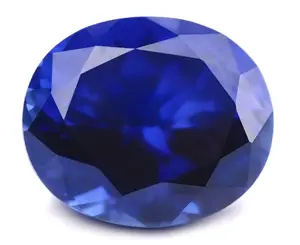
Gemstone Identification and Grading
The ISG Gemstone Identification and Grading Course is a complete education in colored gemstones that will provide a professional-level education for the student to work in the gemstone industry. This course is taken directly from the ISG Registered Gemologist Appraiser Diploma Program. It provides the student with a professional education in colored gemstone formation, why gemstones have color, how to identify gemstones, how to evaluate gemstone quality, and the various gemstone phenomena. This is a complete professional education in colored gemstones. A free preview of this course is available below.
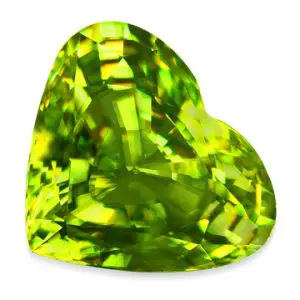
Natural sphene heart
The course consists of 12 lessons from the RGA Program with many high-quality images and demonstrations to help the student get the highest level of education.
Tuition: US$395.00
Certificate of Completion: Yes. You will print your Gemstone Identification and Grading Course Certificate from your Student Profile.
How to Begin:
- When you pay for this course using a credit card, you can use PayPal or our new STRIPE Credit Card Payment Gateway.
- SSL Secure Payments can be made through STRIPE.
- Click on the BUY NOW button on the upper right side of this page.
- The payment gateway will take you to the PayPal and Stripe payment system icons.
- Once you receive payment confirmation you will be brought back to your course to begin or to the Gemology.pro website. Either way, go to the course home page to begin. You can also access the course page through your Profile Page available at your user name in the top right corner of the home page.
- Once you have returned to the course home page click the Start the Course button to begin.
- Once your complete your course, go to the Certificates and Badges of your Profile by clicking on your Username in the upper right corner of the website. You will print your Gemstone Identification and Grading Course Certificate of Completion.
Colored Gemstone Identification and Grading
 Download the Gemstone Reference Guide
Download the Gemstone Reference Guide
This Guide compiles all of the information including photographs, descriptions, properties, identification methods and more for 82 of the most often seen gemstones. This guide can be opened and downloaded on PDF file that includes a full Table of Contents you can use to find just the gemstone you need. This is another service of your International School of Gemology to help you be the most successful gemologist and jewelry appraiser possible. Please contact the ISG office for any questions. This will be utilized throughout your ISG Colored Gemstone study.
Part 1: Getting Started
Welcome to the ISG Colored Gemstone Course section. In this first lesson, you will learn what colored gemstones are, how they form, why they have color, and be briefly introduced to gemstone crystal forms. The purpose of this lesson is to form a foundation of understanding that will help you apply practical methods of gem identification later on in this course. To apply practical identification methods, one has to go beyond reliance upon gemological equipment, and acquire a basic knowledge of gemstone formation and an understanding of why gemstones have color. You will also learn to view gem identification differently from what is taught in most gemology schools
 For instance, look at the photograph at left. What do you see? Stop for a minute and think of the possibilities of what kind of gemstone this might be. Do you think it might be citrine? Sapphire? Tourmaline? Garnet? All are possible, right? But where does that kind of evaluation leave you? With a lot of questions and few answers.
For instance, look at the photograph at left. What do you see? Stop for a minute and think of the possibilities of what kind of gemstone this might be. Do you think it might be citrine? Sapphire? Tourmaline? Garnet? All are possible, right? But where does that kind of evaluation leave you? With a lot of questions and few answers.
Now look at the picture again. What can you see that it is not? Well, it’s not a peridot. It’s not an amethyst. It’s not many things. Now you are getting somewhere, because the concept of practical gem identification is not trying to determine what something is but determining what something is not. When you start thinking about gem identification as a process of elimination, you will be on the road to practical gem identification.
Let’s go back to our examination of that orange stone and imagine you are at a booth in the Days Inn Hotel in Tucson, Arizona, and you have only a few pieces of gemological equipment — a 10x loupe, a diffraction grating spectroscope, a Chelsea filter, a dichroscope, and a hand torch or penlight. You are looking at a very nice stone that the owner has told you is an unusually large specimen of spessartite garnet, sometimes referred to as mandarin garnet. What will you do with so few instruments and no electricity?
In this case, your 10x loupe or dichroscope will tell you it cannot be orange tourmaline or citrine because it is single refractive which also eliminates orange sapphires and any other double refractive stone. You know it’s not an orange cubic zirconia because the facet junctions are much too sharp. This greatly narrows the field of possibilities, so it must indeed be spessartite garnet. And you come to this conclusion because all of the above went off in your head in about two minutes, using pure logic from looking at the stone.
What just occurred in the scene above is that you used a practical approach to gem identification, by taking just a little time and thinking of what it could not be, and then eliminating everything else until you have only one choice. Does this happen all the time? No. Sometimes you are going to get a stone that has a couple of possibilities and you will need additional tests. But again, you will use a practical approach; you will admit to yourself that you cannot be sure of the identification because there are other possibilities and you need more testing. If you are truly interested in the stone, you will make arrangements for further testing, but you won’t buy the stone simply on someone else’s identification that you do not have a chance to verify. That is the practical approach.
All too many trained gemologists are lost without their refractometer and polariscope, mainly due to an over-reliance on equipment and a lack of knowledge of gemstones. The more you study about gemstones and their properties, the more reliable this practical approach will be for you and the less equipment you will rely on when you are in the field. It may be useful to have a refractometer and polariscope to confirm your findings, but the key is to be able to make identifications without having to carry around a lot of equipment and reference books.
Definition of a Gemstone
Beauty + Durability+Availability = Gem Material
<p “>A gem material does not have to be a stone. Many other materials, such as amber, coral, pearls, and others are also gems. But regardless of the source, all gem materials must possess three properties to be classified as gems.
First, gems must have beauty. If it’s not pretty, no one will want to buy it, so the material must have beauty. Second, it must be durable. If it does not wear well and breaks easily, it won’t succeed as a gem because it will not last. Consider a stone like kunzite, a very nice gemstone that was once popular, but kunzite is quite fragile; the gemstones did not hold up well to wear so their popularity decreased greatly in just a few years. They were pretty but not very durable so they have not done very well as gemstones. Third, the gem material must be available. There must be enough of it available to create and sustain a market. A beautiful gemstone that has durability is desirable, but a market cannot be created for a stone that will not be available in sufficient quantities to sustain customer demand. Such was the case with fine Brazilian Paraiba tourmaline. The genuine material was mined for only about two years. And although there is still material being mined that is close to the look of that first Paraiba tourmaline, none has truly duplicated the finest Paraiba tourmaline that was mined from Brazil. A large market was started for the stone, but there was just not enough to meet demand, and the marketability of the stone crashed. Today it sells for very high prices when one can find it the authentic material, and not the treated material from Mozambique that emulates the true Brazilian Paraiba Tourmaline.
For a gem material to be truly a gemstone, it must be beautiful enough to make someone want to buy it, be durable enough to withstand a lot of wear and tear, and be available enough to supply a large market of demand.
What is a Gemstone?
Ask most gemologists “What is a colorless sapphire?” and you will probably be answered, “A colorless sapphire is corundum without coloring elements.” But what is corundum, and what are coloring elements? The real answer is “A colorless sapphire is pure aluminum oxide in crystalline form.”
A colorless sapphire is a crystalline form of aluminum (like what’s in the foil used to cover food) and oxygen (as in the air we breathe). How does aluminum and oxygen end up being a colorless sapphire? Let’s look at the following examples to see how that happens.
Here is a basic sapphire molecule made of two atoms of aluminum and three atoms of oxygen. This is a simplification of this concept, but it gives you a basic idea of the chemistry and how a colorless sapphire starts growing. And by growing, we mean that when the crystal forms it literally grows.

As the crystal forms, molecules of this aluminum and oxygen combination adhere to each other, growing a crystal of sapphire. One molecule at a time.

Eventually an aluminum oxide crystal form. One molecule joins to another, to another, to another . . . until you get something like the graphic below, where aluminum and oxygen atoms combine to form aluminum oxide molecules. Before too long the group starts getting bigger and bigger until it is visible. Forming a crystal shape, which is what we call colorless corundum

This is how most gemstones are created. Take opal as an example, made of silicon and oxygen, much like the silicon in silicon glue and the oxygen you breathe, built layer upon layer. And an amethyst is made of silicon and oxygen also, built layer upon layer. This is how crystals grow and how gemstones form. The crystal shapes that you will see at the end of this lesson are the same formations of the very first atoms that started the gemstone crystal growing. In the next section, you will learn how the gemstones form in nature on a much larger scale.
How Gemstones Form
We are going to cover only the three basic processes of rock formation in this section. Enough will be explained for you to understand how gemstones form in the earth, but we will not go into as much detail as some gemology courses. The study of gemstone formation is a very large and interesting topic that you should continue to study, but for this course you will be required to have only a basic understanding. <h3 “
Igneous Rock Formation

Gemstones, for the most part, form as crystals inside various formations in the earth. In some cases they form deep within the earth and then are brought to the surface by volcanic action. Magma pushes its way to the surface, providing a source of gem bearing rock known as igneous rock. The photo on the left is an example of where igneous rock has pushed its way to the surface in this formation of Texas pink granite found in Mason County, Texas.
An important formation that occurs as a result of this magma intrusion is the pegmatite dike. This is a place where magma, or sometimes a hot water solution caused by the magma, has pushed into pre-existing rock, and the rock melts. The area where the magma or hot water meets the host rock is called a contact zone. In these contact zones, where the pegmatite dike intrusion and the host rock melt and cool, many gemstone crystals are formed in these locations.

At left is a layer of basaltic lava rock that covers the area around Plush, Oregon and produces the Oregon Sunstone. A video of this material is above.
Most of the gemstone formations of Brazil are due to pegmatite dikes intruding into the host rock. Some of the pegmatite dikes in Brazil can be many miles (kilometers) long and many yards (meters) wide. This is where gemstones like amethyst, citrine, tourmaline and topaz form, and why Brazil is such a rich source of gemstones.
The first picture below is at the site of a very small pegmatite dike in Mason County, Texas, that produces topaz. Notice the long slender intrusion into the rock. This is where very, very hot water under extremely high pressure forced its way into cracks in the rock and melted some of the host rock material. Because of high silicon content, most pegmatite dikes create large veins of solid white quartz when they cool. Other kinds of gemstones also form from the liquid solution before complete cooling takes place.

View of a pegmatite dike intrusion seen as white lines running through the host rock. Above right: Close up showing the quartz interior of the intrusion “vein”.
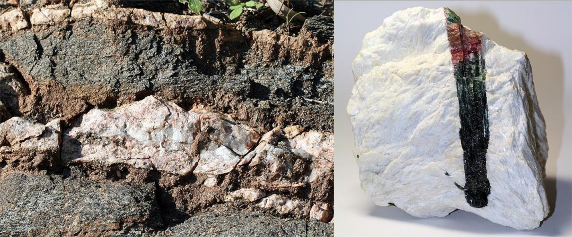
Above left: Close-up of quartz pegmatite. Above right: Tourmaline crystal in pegmatite quartz that was unfortunately shattered during mining, from Brazil
Sedimentary Rock Formation

Sedimentary rock is formed when rock formations on land erode and wash onto the sea floor, building layer upon layer of sediment. After many millions of years, the layers become so deep and so heavy that heat and pressure cause the sandy sediments to form a mostly calcium carbonate rock called limestone. As can be seen in the photo to the left, the layers in sedimentary rock can tell the story of Earth’s past.

Sometimes sea creatures which have been preserved as marine fossils can be found in this type of rock. Occasionally an ancient sea sponge will be found in the form of a flint nodule from which the American Indians and other early cultures made arrowheads and cutting tools. These flint nodules formed where a sea sponge was covered up with sediment. Since the sea sponge’s body was almost pure silicon, as its remains changed form, it turned into a nodule of flint like the one in the photo on the left. So whenever you see a flint arrowhead, you are actually seeing the fossilized remains of a very ancient sea creature.
Very few gemstones are found in sedimentary rock. Those that exist are usually pre- existing gemstone crystals that eroded and washed into rivers and oceans, settling on and into the layers of sediment.
Metamorphic Rock Formation

Sometimes rock is subjected to so much heat and so much pressure that it melts and reforms. As the melted host rock recrystallized, new rocks formed based on what minerals were present. Rock formed this way is called metamorphic rock. Most of the earth’s crust is composed of metamorphic rock
Often metamorphic rocks are created by the intrusion of a pegmatite dike. The photo above is another place in Mason County, Texas, where a pegmatite dike has pushed into the rock, this time causing it to turn into black schist. (This formation is about 13 feet, or 4 meters, high.) The pegmatite intrusion is the pinkish white veins. The black schist is the dark rock on the sides and in the middle, where it has formed around the pegmatite intrusion. Another metamorphic rock, marble, is formed when limestone is subjected to tremendous heat and pressure, usually due to pegmatite intrusion. The result of the Mason County intrusion on the pre-existing rock can be seen in the images below. Below right the rock has been literally bend back as demonstrated by the bent layers, and the deformed rock below right shows extreme pressure has been placed in this area.
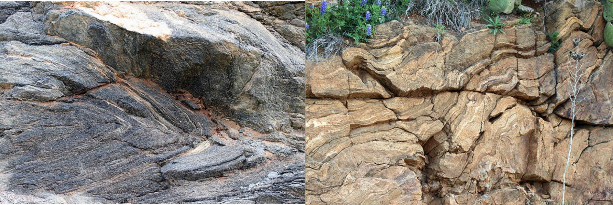
Many gemstones form during the process of metamorphic rock creation, when crystals are allowed to form as the re-melted host rock cools. Some familiar gemstones that occur in metamorphic rocks are ruby, sapphire, chrysoberyl, and emerald.
Why Gemstones Have Color
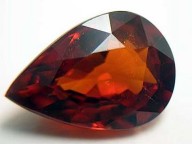
Let’s consider the fact that most gemstones in their purest state will be colorless, such as colorless quartz, colorless beryl, colorless tourmaline, colorless topaz, colorless corundum, etc. This is mainly because, in their most basic stage of formation (atoms building molecules), there is usually nothing in those “building blocks” to provide color. Look at the example of a single colorless sapphire molecule below. The purest form of colorless sapphire — one atom of aluminum and two atoms of oxygen — have nothing to offer in the way of color. Color most always comes from something outside of the stone’s basic structure. These things that add color are called impurities. Most gemstones get their color from impurities that are introduced into their crystal structure.

At left are three oxygen atoms joined with two aluminum atoms, our first building block in the creation of colorless corundum, also called a colorless sapphire.
Let’s imagine that in the hot mixture from which the corundum is starting to cool and crystallize there is an ever so tiny amount of chromium running around in the mix which attaches itself to the aluminum oxide molecule. Now suddenly we have a mixture of aluminum, oxygen and chromium as shown below.

With chromium added to the “mix”, it has now become a ruby. How does the chromium cause color in corundum, making it red? There is a complicated chemistry and physics explanation for this, but suffice it to say that chromium “hides” most all colors from the human eye except red, so rubies are perceived as a red gemstone.
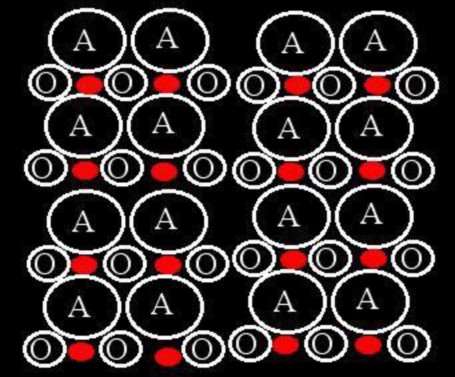
The corundum molecule with the chromium impurity begins to grow. There is enough chromium present to attach to more aluminum oxide molecules. The crystal grows with the chromium.
Compare the colorless sapphire concept crystal below left, to the concept ruby below right.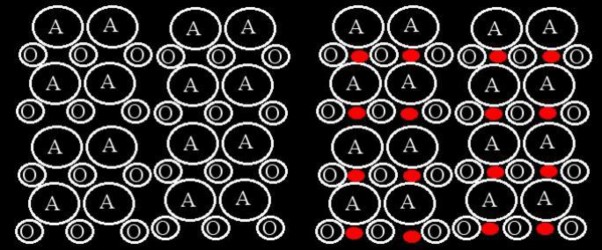
The only difference is the presence of chromium that adds color. If we were to do the same demonstration above using a double impurity of iron and titanium, the result would be a blue sapphire.
This is basically how all gemstones gain color. To provide another example, let’s consider a molecule of beryllium aluminum silicate. With no impurities, beryllium aluminum silicate is the gemstone known as colorless beryl. But if we add chromium (just like the chromium used to make ruby), the colorless beryl will become an emerald. (You will learn in a future lesson how chromium can cause both green emeralds and red rubies.) Put some uranium into a molecule of beryllium aluminum silicate (colorless beryl), it becomes golden beryl of heliodor. Iron added to colorless beryl creates aquamarine.
These same impurities that cause color are also the source of inclusions in gemstones. Inclusions are impurities that can be large enough to be seen under a loupe or microscope, and sometimes even with the naked eye.
Impurities as coloring agents are valuable clues to the identity of many gemstones. It is important to remember that the impurities in most gemstones are the major cause of color and are also the major cause of inclusions.
The Seven Crystal Systems

Most gemstones grow in shapes called crystals.
A crystal is a large formation built upon an orderly arrangement of atoms that, if reduced to its most basic size, will be the same shape as the first few “starter” molecules. These various shapes of crystals are separated into groups called crystal systems, separated by their various shapes or type of symmetry. Certain gemstones will grow in certain crystal systems, meaning that an emerald will always grow in the hexagonal system, a diamond will always grow in the cubic system, etc. Sometimes crystals can grow quite large. These large crystals are usually stones that grow in pegmatite dikes, especially quartz and topaz. Many topaz crystals grow to weigh several tons or thousands of kilos!
On the other hand, some gemstones only grow in very small crystals, as in the case of the rare green form of garnet known as tsavorite, or the previously mentioned red beryls that are sometimes called red emeralds. These stones are rather scarce and only small faceted examples are available. A true tsavorite or red emerald of 1.00 carat or more would be quite rare, so it would be expensive. Knowing the type and size of crystals a gemstone produces will help you better understand some of the price aspects of the gemstones you will be studying in this course.
Crystals Inside of Crystals
Before we look at specific crystals, let’s talk a little about crystals that appear to have formed inside other crystals. Actually, these crystals usually do not form inside one another but beside each other. This is how many inclusions occur in gemstones, and happens when one crystal has grown in proximity of another crystal — but either the large crystal had grown faster or (most likely) the smaller crystal had stopped growing and became engulfed by the other.

Here is an example of how a garnet crystal can become an inclusion in a diamond. Two small crystals, one diamond and one garnet, where the diamond crystal is still growing but the garnet has stopped growing.

As the diamond crystal grows, it starts to engulf the garnet crystal.

Eventually, the garnet is overtaken and engulfed inside the diamond.

The garnet is now an inclusion inside the diamond.

Here you see actual garnet crystals inside of a diamond, in low magnification (far left) and high magnification (immediate left). This garnet crystal existed at the same time the diamond crystal was formed and was enclosed in the diamond crystal as it grew.
Phantom Crystals and Intergrowth Crystals
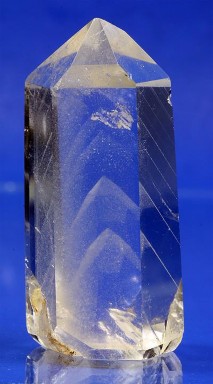
Sometimes crystals will stop growing, then restart again. As other material deposits on the surface while growth is stopped, when the crystal begins growing again it will leave multiple surface layers visible as you see at left. This is known as a “phantom” crystal, as the many different surfaces inside create what appear to be phantom crystals inside. Sometimes whole crystals will be included in another crystal or will form as an intergrowth with another crystal. We will talk about this later in this lesson.
Three terms are used to describe crystals inside of other crystals. These three terms can also apply to other types of inclusions. They are protogenetic, syngenetic and epigenetic inclusions.
Protogenetic inclusion are those that existed before the larger crystal started growing. The big crystal grows and engulfs another in the process, as in the illustration of the garnet becoming included in the diamond.
Syngenetic inclusions are those that grew at the same time but at a slower rate than the larger crystal in which they are found. Like the phantom crystal at left, the more slowly growing crystal becomes engulfed in the larger crystal and stops growing once inside the big crystal.
Epigenetic inclusions are those that form after the big crystal has finished growing. This is usually due to a re-heating of the host crystal (as in the metamorphic rocks) when the big crystal gets so hot that part of it melts. New inclusions form as part of the re-heated, cooling crystal.
What Every Gemologist Should Know About Crystals
A gemologist can misidentify a gemstone if he or she is not aware of its crystal system, so it is very important to understand a few basic properties of crystals. Crystallography as a science is a complex study that we will touch upon only briefly. Only the basics of crystallography need to be learned to be able to apply practical identification methods.
Before continuing with our discussion, let’s look at some interesting crystals shown below. Note the different shapes crystals can come in, and that crystal systems may include more than one shape.
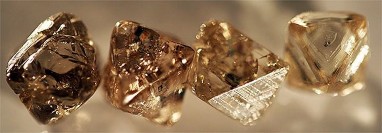
Diamond as an octahedron, a shape in the cubic crystal system.
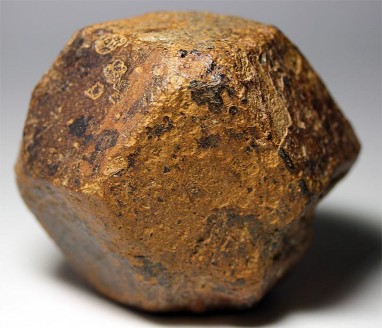
Single garnet dodecahedron crystal with 12 crystal faces and weighing 4.4 pounds (2 kilos), a shape also of the cubic system.
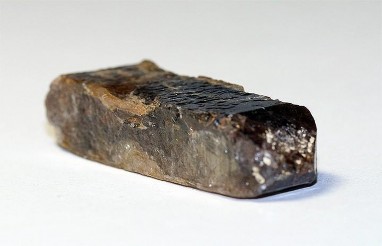
Classic tetragonal zircon crystal (tetragonal system).
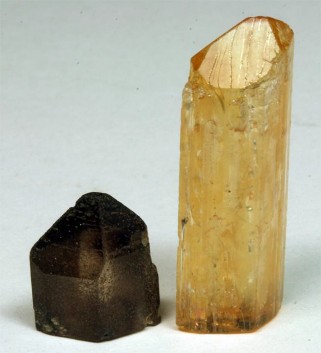
Topaz showing termination as an orthorhombic crystal (orthorhombic system)
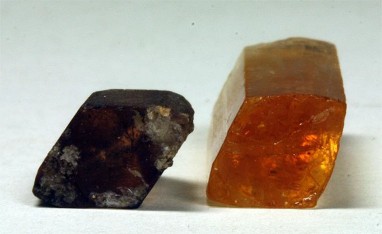
Classic view of a topaz crystal (orthorhombic system) through the C axis, or long axis.
Crystals have what are called crystal axes. These crystal axes are the direction in which light travels through the stone. It is very important to understand and remember that gemstones have more than one axis providing a direction of light travel.
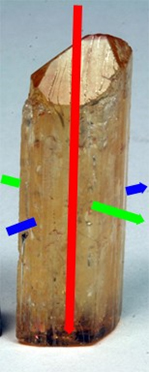
For an example of this, look at the graphic above. Here we see an illustration of a topaz crystal like the ones in the photos above. The red line indicates the “C” axis of the crystal, while the green line denotes the “ordinary ray” and the blue the “extraordinary ray”. The light traveling down these particular directions will be changed in different manners by the stone, meaning that the gemstone will offer multiple colors and reactions to gemological testing. We will cover this more in a future section, but for now it is important to know that gemstones will offer variable optical properties based on their crystal structure. For this reason it is very important to learn the crystal systems in order to best understand gemstone optical properties.
This leads to the second important issue: gemstones have more than one direction for you to test with your gemological equipment. This is why you will always need to rotate any stone you are testing to make sure you are seeing all of the possible light reactions. It is very important to remember that gemstones can give different reactions to gem testing equipment based on what direction from which you are looking at them.
Here is a “real life” example using tourmaline. These two photos show the directional properties of tourmaline, which means that the stone will look different depending upon what end or side of the crystal you are looking at.
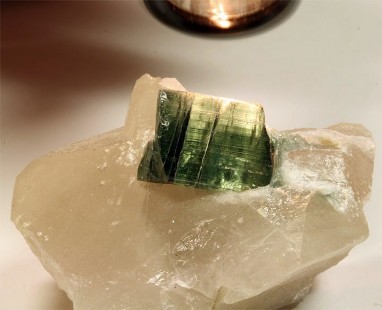
In the first photograph, notice how the light is entering this tourmaline crystal still in matriz from the side and how the stone looks green.

Now, look at this very same tourmaline when the light is transmitted through the end (C axis). The stone looks so dark as to appear almost black.
If you were faceting this tourmaline so the best color would show, where would you place the table, the flat top of the faceted stone? Looking at the two photos above, do you think you would cut the table of the stone parallel to the C axis or perpendicular to the C axis? You would want the green color to show, so the table would have to be parallel to the C axis. If it were perpendicular to the C axis, the stone would look so dark green it would appear almost black. If you have ever seen these dark green/almost black tourmalines in the jewelry store and wondered why they were so dark, now you know what happened to them!
If you were testing this tourmaline with some gemological instruments and looking at it through the long end, or the C axis, you would see darkness. If you then rotated it to look at it from the sides you would see green. This is why you need to be aware of the crystal structure of gemstones, and why you need to always rotate any gemstone you are testing to be sure you are “getting the whole story”.

